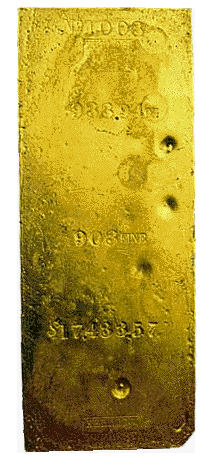|
A Barbaric
Relic for a Billionaire The Gold
Brick Eureka holds two records; the highest weight and highest stamped value, and it is so large that it required two hallmark stamps of the assayer. Many refer to the ingot as The Crown Jewel from the Ship of Gold, which was in fact the name of Gary Kinder's great book about the SS Central America. (As I write - Nov 10, 2001 - Amazon have the hardback on sale for $5.99!). The Disaster The Panic
of 1857 California gold had fueled the country's economy since its discovery in 1849, and the disaster came at a perilous time and threatened to take the financial underpinnings of the United States with it. Despite the shipwreck being the worst peacetime maritime disaster in American history, with the appaling loss of lives, the newspapers gave a lot of prominance to the appaling loss of wealth! Indeed "TOTAL LOSS OF THE TREASURE" was the New York Times headline of Sept 19th 1857. The Panic of 1857 took hold, ruining both men and businesses. And despite attempts to locate the wreck the Central America remained beyond the reach of man and his technology, lost in the unfathomable depths of the Atlantic, ever elusive, for over one hundred and thirty years. The Salvage The salvage and recovery of the Central America were carried out by Tommy Thompson and the Columbus-America Discovery Group, (161 Ohio investors with a $12 million dollar stake) utilizing a remarkable 'robot' named Nemo. Nemo weighed six tons and looked like a cardboard box which'd had random bits and pieces of scrap metal and electronics glued to it. Nemo, despite its ungainly appearance utilized 3-dimensional video imaging and carried an array of lights, lobster-like arms and a vacuum. The first gold ingots were spotted in 1988. Amidst rotted wood, scattered gold dust, and coins lay Gold Rush bars, some glinting brilliantly in the glare of Nemo's lights. For 11 years three tons of gold bars and coins from the Central America, worth about $100 million, lay in vaults in Norfolk and Chesapeake while lawyers fought over who would keep them. It was the longest-running case in Norfolk's federal court. Obviously the decendants of the original insurance companies felt they had a rightful claim to a share of the treasure. Indeed, in 1857, because the nation was in a panic about the loss of the gold, the insurers had pulled out the stops, and had paid up almost instantly. (The London Insurance Company paid Wells Fargo $150,000 within 3 hours after notification of the loss in 1857, such was their need to reassure the restless community). The rest of the treasure was finally sold to the California Gold Marketing Group, the group of private investors who sold the 8 million dollar 'brick' last week. Eureka, and many other gold bars, coins and nuggets of the Central America treasure have traveled the nation and have been the highlight of museum exhibitions and tv spots. Thousands of people have been inspired, by the awesome gold, to become collectors of rare gold coins and ingots. The Auction The auction catolog itself was a treasure; one beautiful publication with the most wonderful photographs and over 200 pages. Incidentally the most expensive of the pieces sold at the Sotheby's auction fetched $308,000. Lot #92 - a Justh and Hunter gold bar 652.84ozs - 896 FINE / $12091.90. Do the math, the 652 oz bar went for $308,000 at the auction - The 933.94 oz Eureka sold for $8 million. Eight million - that is $8,565 an ounce! Barbaric relic? duh. --Barb Moriarty |
 Gold @ $8565 an ounce!
Gold @ $8565 an ounce!